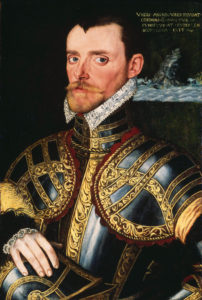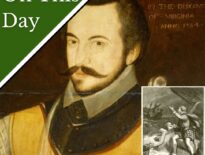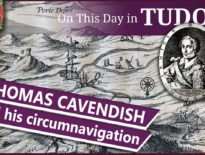 Richard Hawkins was born in Plymouth and was the only son of Sir John Hawkins and his first wife, Katherine Gonson. His mother was the daughter of Benjamin Gonson, the treasurer of the navy, the position his father John took in 1577, so the seafaring life was in his blood. Little is known regarding Richard's education; it isn't clear whether he attended university or an inn of the court, but he had reasonable fluency in Latin and the educational skills expected from gentlemen at the time. Therefore, although he grew up among ships and seamen, he will have enjoyed a period of schooling, presumably in Plymouth. A lot of what we know about Richard Hawkins comes from his autobiography 'Observations of Sir Richard Hawkins, knight in his voyage into the southern sea, A.D 1593, which he wrote until around 1599. Although written by Richard himself, it isn't easy to know whether all the details are correct.
Richard Hawkins was born in Plymouth and was the only son of Sir John Hawkins and his first wife, Katherine Gonson. His mother was the daughter of Benjamin Gonson, the treasurer of the navy, the position his father John took in 1577, so the seafaring life was in his blood. Little is known regarding Richard's education; it isn't clear whether he attended university or an inn of the court, but he had reasonable fluency in Latin and the educational skills expected from gentlemen at the time. Therefore, although he grew up among ships and seamen, he will have enjoyed a period of schooling, presumably in Plymouth. A lot of what we know about Richard Hawkins comes from his autobiography 'Observations of Sir Richard Hawkins, knight in his voyage into the southern sea, A.D 1593, which he wrote until around 1599. Although written by Richard himself, it isn't easy to know whether all the details are correct.
His first known voyage took place in 1582 when he sailed under the command of his uncle, William Hawkins, to the West Indies. Three years later, Richard was given his first command of a vessel, commanding a galliot named the Duck during Drake's raid on the West Indies. He was the first to return and bring back news of the success of that particular expedition. The Duck was a relatively small ship, but it would have taken considerable skill to command it. For Richard to be placed in command of the vessel at a young age is indicative of his ability. His skill as a seaman can be further evidenced in 1558 when he was entrusted with the command of the 360-tonne ship named the Swallow in the naval campaign against the Armada. He sailed in the squadron commanded by his father and managed to remain unscathed throughout the ordeal. However, one issue for Richard was that his career was overshadowed by that of his father and he longed for a reputation of his own and for individuality.
In 1590, Richard accompanied his father to the coast of Portugal in command of the Crane. Then, he accompanied him to the Azores where he was made vice-admiral and captain of the queen's ship, the Nonpariel. Following this, it seems that Richard was given a commission that would require him to sail around the world under the guise of exploration and discovery. Still, the real commission was to attempt some 'enterprise against the king of Spain.' His subsequent actions seem to support that claim, and from 1593 it appears Richard was engaged in acts of war - and to a certain extent espionage - against Spain.
Richard left Plymouth in a ship named the Dainty in the middle of June and set sail for the West Indies, the Spanish Main and the Southern Seas. Rough seas, storms and scurvy marred the first part of the voyage. It appears that during this time, he had in his possession an apparatus that allowed him to distil seawater which, if true, would be extraordinary for the time.
By November, Richard had reached the Santa Anna Islands to the north of Cape Frio. Richard left the coast of Brazil around the middle of December, and on 2nd February 1954, he sighted land, which is now the Falkland Islands. However, at the time, he named them Maidenland in honour of the queen. On 10th December, the Dainty entered the Strait of Magellan. It reached the Pacific safely around the end of March and reached the island of Mocha on 19th April. In May, Richard attacked and plundered the town of Valparaiso; however, shortly after, the Dainty was captured at San Mateo by two Spanish galleons. The reduced crew onboard the Dainty of around 75 men was no match for the Spanish galleons and after a three-day stand-off, which resulted in Richard getting severely wounded, they surrendered.
The commander of the Spanish ship, Beltran de Castro, stated that the prisoners of war should be spared and returned to their own country. The first part of his pledge he honoured, and Hawkins was able to recover from his wounds. However, shortly after this, the Inquisition attempted to claim Hawkins and his men. Although Beltran attempted to hold them off, the Inquisition won, and Richard and his men were captured. Richard was held prisoner in Lima for almost three years until September 1597, when he was transferred to a prison in Seville. In September 1598, he tried to escape; however, he was shortly recaptured and placed under strict surveillance. His Observations came to an end with his capture and imprisonment at San Mateo, but he wrote of his attempted escape in a separate account which he addressed to the Earl of Essex and smuggled out to him in 1599. Following his imprisonment in Seville, Richard was moved to Madrid, where he wrote letters to the English ambassador in France and to the queen herself, presumably to secure release. Before this, in 1595, his father died and had left £3000 to put towards his ransom; however, there was no evidence that this was used to help secure his release. The officer who initially captured Richard, Beltran de Castro, also attempted to use his influence to secure Richard's release. In June 1602, Richard addressed a plea directly to Sir Robert Cecil, which finally succeeded, and he was eventually released after eight years in captivity.
Following his release, Richard returned to Plymouth and resumed his old life. In 1603-4, he was elected as mayor of the town, and on 23rd July 1603, he was knighted by James I. In 1604, Richard was appointed to serve Plymouth in Parliament and was also appointed the vice-admiral of Devon, taking up considerable local responsibilities. In 1604, he also wrote to commissioners charged with the negotiations for peace with Spain, demanding compensation from the Spanish government for his imprisonment and for events that happened during his father's life. These demands for compensation went unheeded by the Spanish, and this did not sit well with Richard and led him to begin abusing his position as vice-admiral. He began to have dealings with every pirate in the local area who looted Spanish ships, using them to gain wealth and pervert the course of justice. He took shares of loot and, in return, granted them discharges with his signature. Richard also supported pirates that attacked Italian and French ships. The Venetian ambassador complained that a ship with his goods on had been looted by English pirates and had ended up in the hands of Richard Hawkins. He was denounced for these actions by the mayors of Plymouth who succeeded him.
Due to his actions and the combination of local and international outrage, the Earl of Nottingham sent his secretary, Humphrey Jobson, to see Richard and investigate. Hawkins attempted to obstruct Jobson, and they had multiple arguments. Hawkins was eventually suspended from office, fined and imprisoned in August 1606. Due to his local influence and friends at court, Richard found himself restored to his post by April 1607. However, following the year 1610 he was not reappointed to the post, reflecting his previous criminal activity as he didn't retire due to old age or ill health, being no more than 50 at the time. In the year 1614, the governors of the East India Company were planning to send an expedition to the Pacific and Richard was named commander. But shortly after, the plan was abandoned, which could have been due to deteriorating relationships with Spain. In 1617, he was again considered for the command of a company fleet but again, this plan was abandoned.
Following the year 1617, we know Richard was at sea frequently, but there are no records of what he was doing. There were no further complaints about him, and he seems to have gained further wealth for himself and his family. Towards the end of his life, he left Plymouth and moved to Slapton, where he owned a small estate, but this did not signify his retirement. In 1620-1, he was appointed vice-admiral under Sir Robert Mansell and commanded the 600-tonne Vanguard. His peers described him as being grave, religious and an experienced gentleman, which may show his transition from his more reckless behaviours. The expedition against Algiers was a lengthy one and proved to be a failure and undermined Richard’s health. He made his will on 16th April 1622 and attended the privy council the following day for business.
It is in the privy council chamber itself where it is said he died of a stroke. His wife Judith survived him until 1629. They had three daughters and two sons, one of whom went out to sea and the other, Richard, who remained on terra firma and continued the Hawkins line in Devon.
by Georgia Whitehead
Georgia has just finished her masters in Classics at the University of Edinburgh. Academically, Georgia is interested in early Christianity, with her master's thesis focusing on "The Male Gaze and Self-Representation in Female Christian Narratives". In addition to her interest in ancient history, she has always been an avid lover of the Tudor era, drawn to the magnificence of the Tudor courts and the larger than life characters. She is particularly interested in The Reformation, Christianity and the shifting sands of ecclesiastical politics in this period and also has a keen interest in the lives of Tudor women. It is Georgia's ambition to become a writer, perhaps publishing her own Tudor novel one day.
Georgia also runs a history blog and instagram page called Historia Mundis.



An interesting article much of which I know. Sir Richard Hawkins is my 10th great grandfather.
I am researching him for a class project so any important stuff i need to know please tell me
Thank you
Richard Hawkins is my 11th Great Grandfather
i JUST DISCOVERED SIR RICHARD. HE IS ALSO MY 10TH GREAT GRANDFATHER.